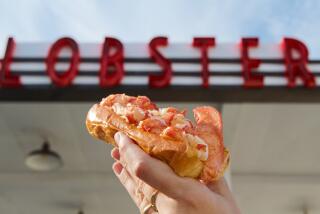The Name Game
- Share via
What’s a pan? Lots of things--the shallow round frying pan, the deeper rectangular loaf pan, the even deeper round saucepan. About all you can say is that a pan’s likely to be shallower than a pot, though a lot of people wouldn’t be able to tell you the difference between a saucepan and a stewpot.
What’s a skillet? A frying pan, but properly speaking, it’s a frying pan with three or four short legs on it. (In New England, people thought these legs gave the skillet an arachnoid look, which is why New Englanders call a skillet--or even a legless frying pan--a spider.) The legs are there to keep the skillet out of the coals, because skillets date from the time when cooking was done in the fireplace.
What’s a kettle? These days, a largish pot used for boiling water; that’s why you make tea in a teapot (which never even goes on the stove) but you boil the water for it in a teakettle. The only dish, apart from soup, that has regularly been cooked in a kettle is the famous “fine” kettle of fish you can get yourself into. This was a meal people used to throw together on picnics with whatever fish they’d caught, so it came to mean a confused mess.
Long ago, the kettle was a much grander utensil, more like a caldron. The Vikings offered sacrifices to their gods in kettles, and certain modern names, such as Tuttle and Axel, reflect this. They come from the Norse personal names Thorketill (Thor’s kettle) and Asketill (kettle of the gods, and if a Viking told you that was his name, it probably wouldn’t have been smart to giggle).
More to Read
Eat your way across L.A.
Get our weekly Tasting Notes newsletter for reviews, news and more.
You may occasionally receive promotional content from the Los Angeles Times.










